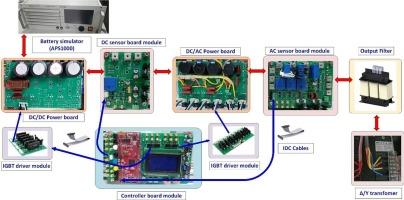Design and implementation of three-phases energy storage system using DSP F28379D for laboratory research
IF 2.1
Q3 ENGINEERING, ELECTRICAL & ELECTRONIC
引用次数: 0
Abstract
This paper presents the hardware design for a three-phases energy storage system connected to the grid through a safe isolation transformer, suitable for use in university laboratory experiments. The power hardware configuration includes a bidirectional DC/DC buck-boost converter and a bidirectional 3-phase 6-switch DC/AC converter. Additionally, the control board uses the Texas Instruments DSP F28379D with a charging-discharging control program written in C programming language and compiled with Code Composer Studio (CCS v12). The current and voltage sensing circuits use Hall-effect sensors to isolate the power circuit from the control circuit. A unique aspect of this research is the modular design, allowing for quick and easy upgrades and changes to the configuration and power capacity, facilitating the testing of control algorithms for the storage system. Experiments were conducted on a 3-phase 380(V) power grid through an isolation transformer and a simulated battery bank powered by the APS1000 amplifier, with a 100(V) output voltage controlled in charging mode from the grid and discharging mode to the grid at a controlled power of 230(W). The results show that the hardware model can be used effectively in laboratory settings to serve educational needs.

基于DSP F28379D的三相储能系统的设计与实现进行了实验室研究
本文介绍了一种适用于高校实验室实验的、经安全隔离变压器并网的三相储能系统的硬件设计。电源硬件配置包括双向DC/DC降压-升压转换器和双向三相6开关DC/AC转换器。此外,控制板采用德州仪器DSP F28379D,采用C语言编写充放电控制程序,并使用Code Composer Studio (CCS v12)编译。电流和电压传感电路使用霍尔效应传感器将电源电路与控制电路隔离开来。本研究的一个独特方面是模块化设计,允许快速轻松地升级和更改配置和功率容量,促进存储系统控制算法的测试。实验通过隔离变压器和APS1000放大器供电的模拟蓄电池组在三相380(V)电网上进行,控制输出电压为100(V),从电网充电模式和向电网放电模式,控制功率为230(W)。结果表明,该硬件模型可以有效地用于实验室环境,以满足教学需求。
本文章由计算机程序翻译,如有差异,请以英文原文为准。
求助全文
约1分钟内获得全文
求助全文
来源期刊

HardwareX
Engineering-Industrial and Manufacturing Engineering
CiteScore
4.10
自引率
18.20%
发文量
124
审稿时长
24 weeks
期刊介绍:
HardwareX is an open access journal established to promote free and open source designing, building and customizing of scientific infrastructure (hardware). HardwareX aims to recognize researchers for the time and effort in developing scientific infrastructure while providing end-users with sufficient information to replicate and validate the advances presented. HardwareX is open to input from all scientific, technological and medical disciplines. Scientific infrastructure will be interpreted in the broadest sense. Including hardware modifications to existing infrastructure, sensors and tools that perform measurements and other functions outside of the traditional lab setting (such as wearables, air/water quality sensors, and low cost alternatives to existing tools), and the creation of wholly new tools for either standard or novel laboratory tasks. Authors are encouraged to submit hardware developments that address all aspects of science, not only the final measurement, for example, enhancements in sample preparation and handling, user safety, and quality control. The use of distributed digital manufacturing strategies (e.g. 3-D printing) is encouraged. All designs must be submitted under an open hardware license.
 求助内容:
求助内容: 应助结果提醒方式:
应助结果提醒方式:


